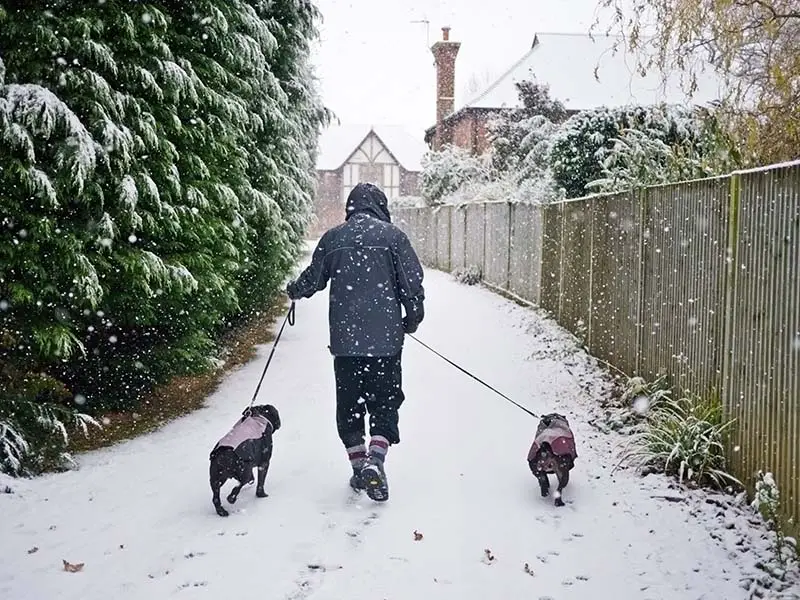As the days get shorter and the temperature drops, there are some factors to consider if you are an outside walker, and you need to know when it is too cold to walk, even if it is something you do just on the weekends.
Below are the signs that the weather is getting close to the danger point and what your options are to maintain your fitness goals.
Contents
How Cold is Too Cold to Walk?
Each region of the country has a different definition of what temperature makes the outdoor weather unbearable.
For most, if the temperature with wind chill is 20 degrees below Fahrenheit, it is too cold to be walking outdoors.
When Wind Chill is Below Zero
When the wind chill outside drops below zero, there are different effects that freezing weather can have on your body. Especially if you have been out walking for quite some time.
Frostbite
If the tissue that is below your skin has gotten cold and begun to freeze, you are experiencing frostbite.
At first, it will feel like it’s freezing, but the numbness from the frigid temperatures is enough to keep you from feeling the pain and the condition will continue to worsen.
In order for frostbite to take effect, the temperature needs to be below freezing.
However, it is much more prevalent once the temperature gets into the teens. Winds along with freezing conditions will also improve the chance of frostbite.
Hypothermia
Another condition you can develop if you are walking in freezing temperatures is hypothermia. This occurs when your normal body temperature has decreased below its normal 98.6 degrees.
Once hypothermia sets in, you may be confused and not aware of your surroundings.
If you have been out in the cold for too long, you need to get into the warmth as quickly as possible.
People who experience hypothermia symptoms also need to seek professional help. Hypothermia can kill.
How To Safely Walk In The Cold

Despite all the weather and health concerns that come with walking in the cold, you may find that you still want to get out there with the appropriate precautions.
Some enjoy the briskness of the cold and want to be outside where the winter action is taking place.
Before you take on the freezing temperatures outdoors, keep the following in mind and prepare as necessary.
Stretch & Warm Up Inside
One of the best ways to stay ahead of hypothermia or frostbite is to get your body to a super warm temperature before you ever go outside.
Make sure you do a good warm-up indoors and stretch so that you have a head start on the cold. Be sure to do full body stretches so all of your body’s muscles are warm.
Dress in Layers
Depending on the day, how much sun is out as well as the wind, make sure that you are wearing plenty of layers.
Being able to remove items as you get warm, or adding more if the temperature drops is essential when walking outside.
The first layer that you put on should be clothing that can wick sweat away from your skin (polyester, nylon, polypropylene) while you are walking.
Your second layer of clothing should be the insulating layer – fleece, down, or wool to combat the cold and help keep the heat in.
The third layer is a thin waterproof and windproof layer that should keep water & wind from penetrating your clothes and allowing conditions like hypothermia to set in.
Cover Your Extremities
Avoiding frostbite means that you are keeping your body safe from the freezing temperatures.
Your arms, legs, and hands need to be covered the entire time you are outside so that the tissue does not freeze while you are getting your fitness in.
Layers of socks, leggings, thermals, gloves, and other warm options are critical so that you can safely beat the freezing cold.
Fuel Up & Hydrate
Before you decide to head out into the cold oblivion to get your walk on, make sure that your body has the nutrients and hydration that it needs.
Without the proper fuel, your body will become tired and can succumb to the colder temperatures that are surrounding you.
Having a high protein meal or pre-workout snack before you head out will give your muscles the energy they need to stay focused and warm while you go on your walk.
While you may have had some water before you head out, make sure you take enough with you to continue that hydration, especially for the longer walks in the cold.
Consider Indoor Exercises
Even if you decide to do some outdoor walking, you cannot stay out for the same time as when the weather is warm.
You need a different solution to maintain your fitness goals and stay moving until warmer weather returns.
The safest way to keep your fitness going when it is cold outside is to take advantage of indoor exercise options.
When walking indoors, you are restricted on your views, but the warm conditions make it safer for your body and reduces the need for additional layers.
You can easily get your steps and mileage in when you opt to use an indoor treadmill.
Whether you have a budget of $1000, $2000 or more, there is a treadmill out there that will adjust to your fitness levels, even as the temperature outside continues to drop.
How Cold is Too Cold to Walk a Dog?

If you take your dog out with you regularly for your daily walks, you should be mindful and know when it is too cold to walk a dog.
While some dogs have different coats and more thickness than others, this does not mean that they want to be outside in freezing temperatures, at least for long periods of time.
The best practice is to not walk your dog if the temperature drops below freezing in your area.
You absolutely do not want to walk dogs in temperatures that are around or below 20 degrees.
Your dog is used to indoor temperatures just like you. Because of that, they also want to walk in warm and comfortable environments.
Give them some time to enjoy the winter goodness, but keep it short and sweet for their protection.
Size Matters
Because dogs come in a variety of sizes, the larger they are, the longer they can manage the cold weather, although the largest dogs should be capped at 30 minutes for a steady walk.
Smaller dogs cannot manage these walks in the cold, even if they have thick coats because their small legs cannot match your strides in these conditions.
Dogs Get Sick Too
Just like you, your dog can fall victim to dangers of cold weather, such as frostbite and hypothermia.
Some people are negligent in this because they assume their large coats will be enough to protect them.
Without the right coverage on your dog, they too, can be exposed to freezing conditions, allowing hypothermia to set in.
While your pup may appear to be enjoying the wintery goodness everywhere, you want to get them back inside and warmed up quickly.
